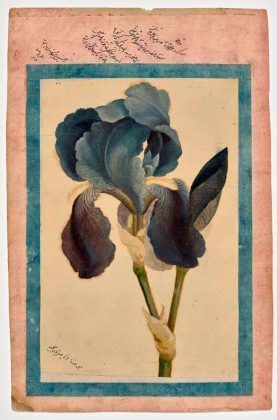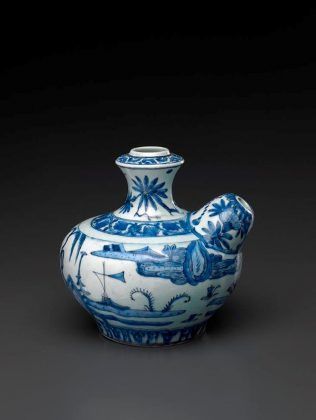Garden Paradise: The Magnificent Safavid Carpet from the Burrell Collection, Glasgow is a rarely displayed masterpiece that was exhibited for the first time in the United States at New York’s Metropolitan Museum of Art last summer before coming to Houston. An unprecedented loan from Scotland’s Burrell Collection, the carpet is currently on display at the Museum of Fine Arts of Houston following its debut at the Met.
[aesop_image img=”https://kayhanlife.com/wp-content/uploads/2018/12/GardenP1-2.jpg” panorama=”off” align=”center” lightbox=”off” caption=”Installation view of Garden Paradise: The Magnificent Safavid Carpet from the Burrell Collection, Glasgow.
” captionposition=”center” revealfx=”off” overlay_revealfx=”off”]
Together with a selection of objects from the collection of Kuwait-based collector Hossein Afshar, the exhibition explores the importance of the garden in Persian culture through the lens of the masterpiece that is otherwise known as the Wagner Garden Carpet.
This rare late-17th-century Persian carpet is one of the three earliest surviving Persian garden carpets in the world, produced under the Safavid dynasty in the city of Kerman in southeastern Iran. Known as The “Wagner” Garden Carpet (a name acquired from a previous owner), it measures 531 centimeters by 432 centimeters (17.42 x 14.17 feet) and was woven with cotton warps; wool, cotton and silk wefts; and wool pile.
[aesop_image img=”https://kayhanlife.com/wp-content/uploads/2018/12/GardenP1-1.jpg” panorama=”off” align=”center” lightbox=”on” caption=”Wagner Garden Carpet, central Iran, early 17th century, cotton warp; wool, cotton, and silk wefts; and wool pile, the Burrell Collection, Glasgow.
” captionposition=”center” revealfx=”off” overlay_revealfx=”off”]
“Through their design, garden carpets evoke an image of the ancient Iranian chahar-bagh – four-quartered garden,” the Metropolitan Museum explains, “with water channels that divide the walled garden and meet at a central pool. In the ‘Wagner’ carpet, the garden – which depicts eternal springtime – also teems with life.”
“Trees, bushes and shrubs,” adds the museum: “are abloom; animals (both predators and prey), birds of all types, multicolored butterflies and moths inhabit the landscape; and fish and ducks populate the waterways. Shimmering water is cunningly illustrated by a lattice pattern drawn with varied thicknesses of line and color.”
The loan to New York’s Metropolitan Museum of Art was made possible by the Mossavar-Rahmani Fund for Iranian Art. The rare carpet was first shown in the United States at the Met’s Sharmin and Bijan Mossavar-Rahmani Gallery (gallery 462), which features masterpieces created under the Safavid dynasty in the 16th and 17th centuries.
The internationally recognized Burrell Collection features some 9,000 items ranging from late medieval art to Chinese ceramics, bronzes and jades, to Islamic pile carpets and French 19th century paintings. It is named after Sir William Burrell, a wealthy Glaswegian shipping magnate and art collector who acquired his collection of predominantly Islamic, Chinese and medieval works over many years before generously gifting it to the city of Glasgow in 1944. The Wagner Garden Carpet was purchased from the Royal Bank of Scotland in 1939.
The loan to MFAH was made possible due to the major refurbishments currently underway at the Burrell Collection in Glasgow before its reopening in late 2020.
Other objects featured in this exhibition from the Hossein Afshar collection include functional pieces such as a mirror case, bowls and a hookah, or ornamental objects such as a 19th century black pear crafted from steel with a restrained gold design. Aimee Froom, the curator of arts of the Islamic worlds at the MFAH selected the flora and fauna themed objects from the Hossein Afshar Collection.
[aesop_image img=”https://kayhanlife.com/wp-content/uploads/2018/12/GardenP1-8.jpg” panorama=”off” align=”center” lightbox=”on” caption=”Plate with Irises, Iran, Kirman, late 17th century, stonepaste; luster painted on opaque white glaze.
” captionposition=”center” revealfx=”off” overlay_revealfx=”off”]
[aesop_image img=”https://kayhanlife.com/wp-content/uploads/2018/12/GardenP1-4.jpg” panorama=”off” align=”center” lightbox=”on” caption=”Star Tile, Iran, Kashan or Takht-i Sulayman, late 13th century, stonepaste; luster and cobalt painted on opaque white glaze.
” captionposition=”center” revealfx=”off” overlay_revealfx=”off”]
[aesop_image img=”https://kayhanlife.com/wp-content/uploads/2018/12/GardenP1-6.jpg” panorama=”off” credit=”The Hossein Afshar Collection at the Museum of Fine Arts, Houston.” align=”center” lightbox=”on” caption=”Bowl, Iran, Tabriz or Nishapur, mid-15th–early 16th century, stonepaste; underglaze painted in black under turquoise glaze, incised.
” captionposition=”center” revealfx=”off” overlay_revealfx=”off”]
The Museum of Fine Arts Houston has entered into a five-year agreement with the collector Afshar to present a series of exhibits at the museum, the first of which entitled Bestowing Beauty: Masterpieces from Persian Lands was featured last year.
Garden Paradise: The Magnificent Safavid Carpet from the Burrell Collection, Glasgow will be running through March 24, 2019.
[aesop_image img=”https://kayhanlife.com/wp-content/uploads/2018/12/Burrell_collection_Glasgow.jpg” panorama=”off” credit=”Author: Helen Simonsson Source: Wikimedia Commons.(CC BY-SA 3.0)” align=”center” lightbox=”on” caption=”The Burrell Collection is in the Pollok Country Park on the south side of the city of Glasgow, Scotland.
” captionposition=”center” revealfx=”off” overlay_revealfx=”off”]




